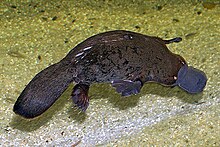单孔目
| 单孔目 化石时期:
| |
|---|---|

| |
| 左上:鸭嘴兽;右上:短吻针鼹; 左下:西长吻针鼹;右下:东长吻针鼹 | |
| 科学分类 | |
| 界: | 动物界 Animalia |
| 门: | 脊索动物门 Chordata |
| 纲: | 哺乳纲 Mammalia |
| 亚纲: | 阴兽亚纲 Yinotheria |
| 下纲: | 南磨楔齿下纲 Australosphenida |
| 目: | 单孔目 Monotremata Bonaparte, 1837[1][2] |
| 下属类群 | |
单孔目(学名:Monotremata)是哺乳纲的一目,仅分布于大洋洲的澳大利亚和新几内亚,因排泄管道和生殖管道末端的开口合为一泄殖孔而得名。牠们以独特的卵生加哺乳的方式繁育后代,为现生哺乳动物中最原始的类群,演化历史可追溯至白垩纪早期,有“活化石”之称。
现存两科,即针鼹科与鸭嘴兽科。针鼹科包含两属四种针鼹,鸭嘴兽科仅鸭嘴兽一属一种[2]。
主要特征
[编辑]单孔目动物与其他哺乳动物一样都是恒温动物。早期的研究指出单孔目动物在控制体温上并未完全发展,但最近的研究却指牠们在不同的环境下仍能维持体温。这是由于单孔目动物会维持一个较其他哺乳动物低的体温(约32℃),而一般作为研究对象的短吻针鼹只会在活跃时才维持正常的体温。因此,动物学家根据这一特征而推断出单孔动物的演化史。牠们应是从其他三叠纪哺乳动物中分化而出,为现存哺乳动物中最原始的类群。
单孔目动物的最大特征,正如其名所指,是牠们没有分开的尿道、肛门及产道,而是由统一的泄殖腔代替。与此相似的结构可在爬行动物中找到。
单孔目动物与爬行动物及鸟类一样,是单靠产卵来繁殖下一代的动物。牠们会把蛋保存在母兽的育儿袋内,由母兽给予养分并孵化,但孵出的幼崽与其他哺乳动物一样,由母乳养育而大。由于没有明显的乳头,幼崽会自行寻找母兽的乳腺吸吮乳汁。一般单孔目动物都较长寿,所以生殖率相应较低,而喂养幼崽的时间则较长。
单孔目体表被毛,成体没有牙齿,从化石类群到现存的鸭嘴兽都是有着“磨楔式”[需要解释]的喙。与其他哺乳动物不同的是,牠们的下颌由单块齿骨构成,而将声音传至内耳的细小骨头则在下颌之上。中耳骨由三组骨头组成,耳孔在下颌底部,无外耳。在牠们的肩胛骨中,有着其他哺乳动物所没有的间锁骨。四肢的运动方式像爬行动物一般在身体两侧,而非在身体下方。后足跟部有刺,称为毒距,雄性鸭嘴兽会从刺的根部分泌毒素用以自卫,而在针鼹中这根刺已失去效用。
下级分类
[编辑]现存单孔动物都生活在澳大利亚和新几内亚等地区。在新南威尔斯,曾发现约1.1亿年前的单孔类下颌骨化石碎片,为已知最古老的单孔类化石,属于一种名为硬齿鸭嘴兽(Steropodon galmani)的史前单孔动物。1991年,在阿根廷南部发现了一块约6000万年的鸭嘴兽牙齿化石。

现生类群
[编辑]化石类群
[编辑]- †寒地掘地兽属 Kryoryctes
- †寒地掘地兽 K. cadburyi
- †十字齿兽科 Kollikodontidae
- †十字齿兽属 Kollikodon
- †十字齿兽 K. ritchiei:约9600万至1.8亿年前
- †十字齿兽属 Kollikodon
- †硬齿鸭嘴兽科 Steropodontidae
- 鸭嘴兽科 Ornithorhynchidae
- †顽齿鸭嘴兽属 Obdurodon
- †O. dicksoni
- †O. insignis
- †O. sudamericanum:约6100万年前;原归类为单孔兽属(Monotrematum),现划入顽齿鸭嘴兽属
- †顽齿鸭嘴兽属 Obdurodon
- †Opalionidae
- †Opalios
- †Opalios splendens[3]
- †Opalios
- 针鼹科 Tachyglossidae
参考资料
[编辑]- ^ Bonaparte, C.L. A New Systematic Arrangement of Vertebrated Animals. Transactions of the Linnean Society of London. 1837, 18 (3): 247–304 (1840). OCLC 8256731. OL 24598787M. S2CID 200872997
 . doi:10.5962/bhl.title.49547
. doi:10.5962/bhl.title.49547  . hdl:10111/UIUCOCA:newsystematicarr00bona
. hdl:10111/UIUCOCA:newsystematicarr00bona  (拉丁语).
(拉丁语).
- ^ 2.0 2.1 Groves, C.P. Order Monotremata. Wilson, D.E. & Reeder, D.M. (编). Mammal Species of the World: A Taxonomic and Geographic Reference (3rd ed.). Baltimore, Maryland: Johns Hopkins University Press. 2005: 1–2. ISBN 978-0-8018-8221-0. LCCN 2005001870. OCLC 62265494. OL 3392515M. NLC 001238428.
- ^ Timothy F. Flannery, Matthew R. McCurry, Thomas H. Rich, Patricia Vickers-Rich, Elizabeth T. Smith and Kristofer M. Helgen. 2024. A Diverse Assemblage of Monotremes (Monotremata) from the Cenomanian Lightning Ridge Fauna of New South Wales, Australia. Alcheringa: An Australasian Journal of Palaeontology. DOI: 10.1080/03115518.2024.2348753
外部链接
[编辑] 维基共享资源上的相关多媒体资源:单孔目
维基共享资源上的相关多媒体资源:单孔目 维基物种上的相关信息:单孔目
维基物种上的相关信息:单孔目 维基教科书中有关单孔目的文本
维基教科书中有关单孔目的文本- Mikko's Phylogeny Archive(米科的系统发生档案馆)网站上有关单孔目的分类信息 (页面存档备份,存于互联网档案馆)
- 加州大学古生物学博物馆网站上的单孔动物简介 (页面存档备份,存于互联网档案馆)
- 《中国大百科全书》第三版网络版中的条目:“单孔目”和“单孔类(化石)”(简体中文)
| ||||||||||||||||||||||||||
| ||||||||||||||||||||||||||||||||||||||||||||||||||||||||||||||||||||||||||||||||||||||||||||||||||||||||||||||||||||||||||||||||||||||||||||||||||||||||||||||||||||||||||||||||||||||||||||||||||||||||||||||||||||||||||||||||||||||||||||||||||||||||||||||||||||||||||||||||||||||||||||||||||||||||||||||||||||||||||||||||
|
| ||||||||||||
Text is available under the CC BY-SA 4.0 license; additional terms may apply.
Images, videos and audio are available under their respective licenses.






